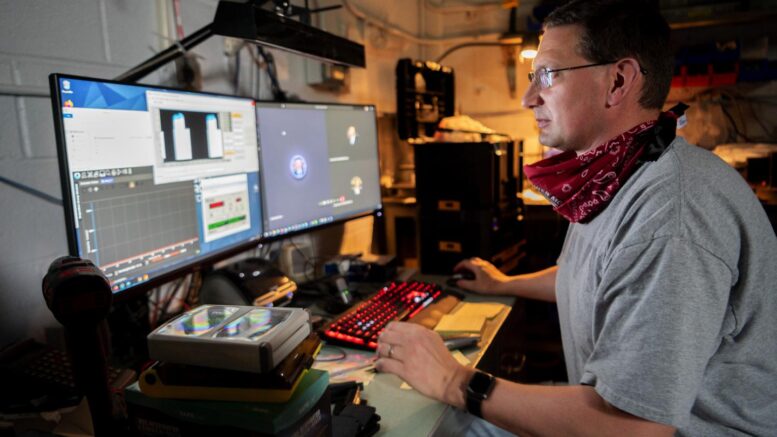Brett Huhman, U.S. Naval Research Laboratory senior research engineer, communicates with other team members over video chat during testing pulsed Xenon gas lamp source in support of COVID-19 at Washington, D.C. May 8, 2020. Huhman has been sending data to six other NRL researchers who have been teleworking to assess ultraviolet light sources applications against COVID-19 for Navy and Marine environments. U.S. Navy photo by Jonathan Steffen
U.S. Naval Research Laboratory researchers evaluated commercial ultraviolet (UV) sources for viral disinfection to combat COVID-19 on land and at sea, and established a dedicated UV characterization lab in five days to ensure safe introduction and effective operation of UV sources across the Fleet.
The Navy is investigating UV-C band (UVC) light as a potential disinfection technique for niche applications against COVID-19 for materiel going onto a ship, for common use areas on a ship, and general room disinfection on ships or shore facilities.
In a short period of time Brett Huhman, in NRL's Plasma Physics Division, reconfigured a laboratory space, conferred with subject matter experts across the NRL Materials Science and Component Technology directorate, and borrowed needed equipment to establish a UV characterization laboratory.
"Testing at NRL includes UV unit longevity and reliability, identifying easy-to-use dosimeters, reflections from shipboard surfaces, and secondary ozone generation from these UV systems," Huhman said. "Scientists at other Navy labs are using NRL data to help them test efficacy against viral loads on Navy and Marine relevant surfaces, such as bare metal tools and painted metal surfaces, and cardboard boxes."
There are numerous companies offering products that produce UV light and are designed for a variety of small and large-scale applications. The Naval Sea Systems Command (NAVSEA) requested NRL scientists to study and characterize the energy density, UV spectrum, and reliability of commercially available units.
"As the Navy wishes to quickly evaluate the efficacy of these commercial sources before procurement, a small investment was deemed necessary, in order to help the Navy 'verify before we buy,'" said Joseph Schumer, branch head for NRL's pulsed power physics group and program manager. "We have learned a lot about the reliability of commercial sources."
Ultraviolet (UV) is light with wavelengths between 200 and 400 nanometers (nm). UV can be divided into 3 bands in this range: UVA (315-400 nm), UVB (280-315 nm), and UVC (200-280 nm). Each band represents a specific part of the UV spectrum and travels through the atmosphere differently. UVC from the Sun is unable to get to the Earth's surface, as the atmosphere will block it.
Testing began in mid-April after NRL received 15 18-watt, hand-held wands from NAVSEA. Since then, the team has tested nine different mercury and xenon-based UV sources with plans to evaluate both LED and plasma-based excimer sources.
"LED and plasma-based sources are emerging technologies, and represent the use of wavelengths not traditionally used for germicidal disinfection," said Huhman. "Mercury sources have historically dominated the market."
Navy researchers continue to evaluate commercial units already being used in hospitals and for other applications for efficacy on Navy-relevant surfaces. The NRL UV team is receiving items on a bi-weekly basis to evaluate.
NRL's work will help identify situations where use of UV provides sufficient viral disinfection at a particular energy level and also develop standard operating procedures to ensure safe UV operation for the Fleet.
Source: U.S. Naval Research Laboratory

Be the first to comment on "NRL Researchers Evaluate Ultraviolet Sources to Combat COVID-19"